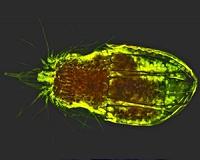| . |  |
. |
San Vicente, Philippines (AFP) April 30, 2010 A Chinese egret pauses in its hunt as a group of fishermen strides across the vast mudflats of Olango island in the Philippines, carrying off baskets of its favourite crab snack. Spring beckons and great flocks of waterfowl are laying on the last layers of fat before the long-haul flight back to mainland Asia, but sightings of the yellow-beaked, green-legged bird are becoming less frequent, experts say. Wild Bird Club of the Philippines member Nilo Arribas, a frequent Olango visitor, fears the worst for the species after observing the egret flocks dwindle in recent years. "Rare species of birds can easily disappear in this site without being recorded or reported," he told AFP. For the tall and graceful wading bird that mainly winters in Olango and two nearby islands, habitat loss is the main threat as tidal flats and estuaries in its northern breeding sites are turned into fish ponds, farms or factories. Just under 3,500 Chinese egrets are believed left, qualifying it for the International Union for the Conservation of Nature's "Red List". Trade in its plumes had nearly led to its extinction in the late 19th century. The IUCN says the birds now breed in protected sites, mainly small islands off the Russian far east, North and South Korea, and northern China. To the south, the nature reserve on the southern tip of the rocky Olango outcrop off the port of Cebu is a vital winter habitat for the egret and dozens of other birds. Reginaldo Bueno, who supervises the 1,030-hectare (2,545-acre) expanse of mudflats, mangrove forests and seagrass beds, says it is among the world's most important wetland sites. More than half the 77 species of migratory birds that use the East Asian-Australasian flyway -- including the Eurasian curlew which has 'near-threatened' status, the Asiatic dowitcher and black-tailed godwit -- arrive in September and leave by April. Both Arribas and Bueno have watched a disturbing decline in bird visitors to the island in recent years. The number of birds stopping off there in winter dropped to 12,000 last year, from 16,000 in 2008, according to Bueno. Human interference appears to be the main culprit. Even though Olango has no fresh water and no local economy to speak of, the last government census revealed human residents now outnumber the visiting birds three to one. Overworked park wardens have in the past year arrested poachers who use a deadly chemical, cyanide, to stun fish. Some mangrove trees have also been illegally cut for firewood, Bueno said. Residents are banned from collecting crabs and seashells in the reserve. However they still gather them in the seagrass just outside the reserve, then cut inside and across the intertidal flats to get to their homes in San Vicente village, scattering the feeding birds. On the outskirts of the reserve the locals collect starfish, sea urchins, and other marine creatures by the thousands, which they preserve using embalming fluid, paint in gaudy colours and sell to foreign markets. "Our livelihood all comes from the sea and everything gets collected here," said one resident, Nimfa Pugoy, 48, a mother of eight However neighbour Giovanni Tanio, 24, said catches were declining. "We are collecting less compared to 10 years ago," Tanio said as he spread out starfish on a tarpaulin to dry in his yard. Filipinas Sotto, head of the marine biology programme at nearby Cebu city's University of San Carlos, said the Cebu region around Olango was no stranger to environmental degradation involving small island ecosystems. Most of Cebu's forests have been denuded, pushing the black shama, a robin-like bird found only in Cebu, close to extinction. "They thought it had gone extinct, but when they found one the government decided to preserve a 100-hectare (247-acre) patch of forest where it now lives," she said. The fate of one species of sea snake on another small island north of Olango serves as a warning, Sotto added -- it disappeared in the 1960s after being hunted for its skin, prized by Japanese for its supposed medicinal properties.
Share This Article With Planet Earth
Related Links Darwin Today At TerraDaily.com
 Explorers Census Hard-To-See Sea Life
Explorers Census Hard-To-See Sea LifeWashington DC (SPX) Apr 29, 2010 Ocean explorers are puzzling out Nature's purpose behind an astonishing variety of tiny ocean creatures like microbes and zooplankton animals - each perhaps a ticket-holder in life's lottery, awaiting conditions that will allow it to prosper and dominate. The inventory and study of the hardest-to-see sea species - tiny microbes, zooplankton, larvae and burrowers in the sea bed, which toget ... read more |
|
| The content herein, unless otherwise known to be public domain, are Copyright 1995-2010 - SpaceDaily. AFP and UPI Wire Stories are copyright Agence France-Presse and United Press International. ESA Portal Reports are copyright European Space Agency. All NASA sourced material is public domain. Additional copyrights may apply in whole or part to other bona fide parties. Advertising does not imply endorsement,agreement or approval of any opinions, statements or information provided by SpaceDaily on any Web page published or hosted by SpaceDaily. Privacy Statement |